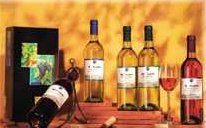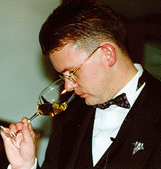| Introduction
| How Wine is made I
| How Wine is made II
| How Wine is made III |
| Climate and Quality
| Serving and Testing
| Wine and Food
|
VII. Serving and tasting wine
Some Basic Guidelines
 If the wine is to be served remember that the wine and food are partners,
and as such, each should complement and enhance - not overpower - the other. Never fill a glass more than half full at any time.
In planning your meal, expect to pour about six half-filled glasses from each bottle.
If the wine is to be served remember that the wine and food are partners,
and as such, each should complement and enhance - not overpower - the other. Never fill a glass more than half full at any time.
In planning your meal, expect to pour about six half-filled glasses from each bottle.
Serve
- White wines chilled to about 50° F (10° C); rosé
- wines taste best a couple of --degrees warmer and red wines should be served at about 64° F (18° C).
- Served too cold or too warm, a wine has neither fragrance nor taste.
- A glass which is somewhat tapered at the top helps contain the bouquet and allows the wine to be swirled in the glass easily.
When opening a bottle of wine...
|
Because of their high natural acidity and crispness, German wines cut through fats,
proteins and strong food flavours, and serve to refresh and cleanse the palate. At the same time,
a German wine's fruit intensity can stand up to the food's own flavour.
If the food has a very strong taste, an intensely flavoured German wine will be called for to balance the food.
Alternatively, if the food is delicate in flavour, a milder and more subtle German wine might be in order.
Taste and styles of wine
 The style of wine depends on the cellar master and is determined in the cellar.
This is not to be confused with quality category, or ripeness, which depends on the weather and is determined in the vineyard.
The style of wine depends on the cellar master and is determined in the cellar.
This is not to be confused with quality category, or ripeness, which depends on the weather and is determined in the vineyard.
As the demand for drier German wines increases, the designations trocken or halbtrocken are seen more often on the label.
A trocken wine is dry - without perceptible residual sweetness. It never contains more than 9 grams of residual sugar per liter and often less.
Halbtrocken wines are off-dry and may have not more than 18 grams of residual sugar per liter.
Do you know...
|
 The ultimate pleasure of wine lies in tasting it.
To reap full enjoyment from this pleasure requires only a moment's concentration, the use of three senses:
The ultimate pleasure of wine lies in tasting it.
To reap full enjoyment from this pleasure requires only a moment's concentration, the use of three senses:- sight - smell taste - and another moment to sum up your impressions of the wine. Jotting down your tasting notes can serve as a very useful reference, particularly if you have discovered certain wines which you feel go well with some of your favourite recipes or meals.
Nearly all German white wines are pale yellow-gold, often with a tinge of green, with those from the Mosel being the
palest of all, while the sweeter German wines tend to be a slightly deeper, pure gold shade. All should be brilliantly clear.

Tasting
Holding
- the glass by the stem - to avoid warming up the wine and unsightly fingerprints
- look at the colour of the wine.
- After observing the colour, swirl the wine by rotating the glass in slow, steady circles.
- This exposes the wine to air and helps to release the wine's full bouquet.
- Next, sniff the wine. Is it flowery, or fruity, or rather neutral?
The aroma should be clean and pure and at the same time complex, emitting scents reminiscent of
apples, berries, peaches or other fruits, of spring flowers or fresh, green fields - each aroma is unique.
- Finally, sip the wine and swirl it around your mouth to enjoy its full flavour.
- In the same way, the aftertaste, or finish of the wine after you swallow, should be a pleasant, lingering sensation.

Drinking wine is culture and a good wine always...
|